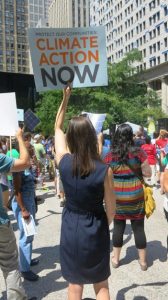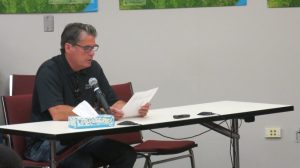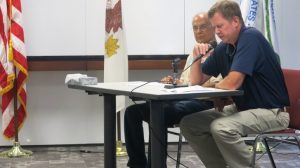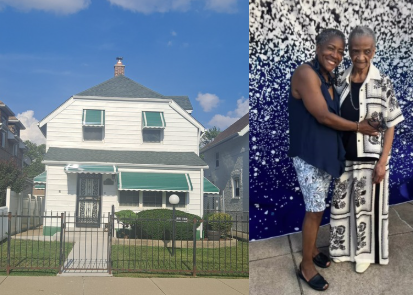Elevate Advocates for New EPA Program for Energy Efficiency in Low-Income Communities
 Last week, the Environmental Protection Agency (EPA) held the first and only hearing on the proposed Clean Energy Incentive Program (CEIP) in Chicago, which encourages investment in energy efficiency and renewable energy in low-income communities. Elevate took the opportunity to let the EPA know how impactful the CEIP could be by providing testimony and helping organize a rally (Elevator Emily pictured at left) with other advocacy organizations calling for Illinois to participate in the CEIP. Over 300 people attended the rally, and nearly 140 individuals delivered oral testimony encouraging the EPA to press forward with this program.
Last week, the Environmental Protection Agency (EPA) held the first and only hearing on the proposed Clean Energy Incentive Program (CEIP) in Chicago, which encourages investment in energy efficiency and renewable energy in low-income communities. Elevate took the opportunity to let the EPA know how impactful the CEIP could be by providing testimony and helping organize a rally (Elevator Emily pictured at left) with other advocacy organizations calling for Illinois to participate in the CEIP. Over 300 people attended the rally, and nearly 140 individuals delivered oral testimony encouraging the EPA to press forward with this program.
What is the CEIP?
The CEIP is a voluntary part of the Clean Power Plan, the nation’s first effort to limit carbon pollution from existing power plants. States can choose to opt-in to the CEIP to receive incentives to develop certain renewable energy projects and double incentives to develop energy efficiency or solar projects that serve low-income communities. This is done by allocating early action emission allowances or emission rate credits (ERCs) to eligible projects for the electricity saved or the renewable power produced in 2020 and 2021 by that project. After awarding early action allowances or ERCs by the state, the EPA will provide matching awards up to a national limit equal to 300 million short tons of CO2 emissions.
Although the Clean Power Plan is currently caught up in a stay of litigation by the Supreme Court, states can still draft implementation plans or decide if they will participate in the CEIP.
What did we have to say?
Elevate Director of Policy Anne McKibbin, Elevate Senior Policy Analyst Suzanne Stelmasek, and Elevate partner contractors Joe Minnich of Minnich Insulation and Tom McElherne of DNR Construction all provided oral testimony to EPA officials, while Elevate also submitted written comments. Below are a few notable points of their testimonies:
Anne McKibbin (pictured at right), Suzanne Stelmasek:
 “We strongly support using the United States Department of Housing and Urban Development’s definition of low income, which is income at 80% of Area Median Income, as presumptively approvable. Our programs in Illinois use this definition and we have found that it qualifies the communities who need energy efficiency most and is practical and easy to implement.”
“We strongly support using the United States Department of Housing and Urban Development’s definition of low income, which is income at 80% of Area Median Income, as presumptively approvable. Our programs in Illinois use this definition and we have found that it qualifies the communities who need energy efficiency most and is practical and easy to implement.”
“Elevate Energy believes that it is critical to the well-being of our communities that they are afforded equal access to evolving technologies and the health and environmental benefits those are able to provide.”
Joe Minnich (pictured below):
 “The CEIP creates incentives to do energy efficiency work and will further encourage building owners to keep working with contractors to make these upgrades. We have received feedback from many repeat building owners that they have noticed a significant cost savings in their heating and cooling utility bills and that they have received positive feedback from their tenants on comfort.”
“The CEIP creates incentives to do energy efficiency work and will further encourage building owners to keep working with contractors to make these upgrades. We have received feedback from many repeat building owners that they have noticed a significant cost savings in their heating and cooling utility bills and that they have received positive feedback from their tenants on comfort.”
“The volume of homes and buildings that are in need of these upgrades are creating many jobs and also allowing small business owners like myself to grow my company. Most importantly, the homes that are most affected by this program are in the Chicagoland neighborhoods with families who would otherwise not have the means to make these energy efficient changes to their homes.”
Much of Joe’s testimony was featured in an op-ed in Crain’s Chicago Business that ran on the day of the hearing.
Tom McElherne (pictured at right):
 “One successful example [of a low-income energy efficiency program that could benefit from CEIP incentives] is the Historic Chicago Bungalow Association’s Energy Savers program. This program provides outreach to low to moderate income families in Chicago neighborhoods to perform energy efficiency upgrades on the unique Chicago Bungalow. They are 40% leakier than the typical house in the Midwest so they do not hold heat well. In many cases, I have seen heating bills exceed $2,000 per year, which for low-income families, can be 10-15% of their annual income. The HCBA program annually helps more than 400 homeowners reduce their energy bills. The CEIP could help extend these opportunities to hundreds more low-income families in desperate need of this common sense assistance.”
“One successful example [of a low-income energy efficiency program that could benefit from CEIP incentives] is the Historic Chicago Bungalow Association’s Energy Savers program. This program provides outreach to low to moderate income families in Chicago neighborhoods to perform energy efficiency upgrades on the unique Chicago Bungalow. They are 40% leakier than the typical house in the Midwest so they do not hold heat well. In many cases, I have seen heating bills exceed $2,000 per year, which for low-income families, can be 10-15% of their annual income. The HCBA program annually helps more than 400 homeowners reduce their energy bills. The CEIP could help extend these opportunities to hundreds more low-income families in desperate need of this common sense assistance.”
“Everyone benefits. Homeowners benefit from decreased utility bills and a more comfortable house to live in. Renters benefit from more comfortable and healthier apartments. Small businesses benefit from steady business and decent profits. Workers benefit from constant work and pay. Our local economies benefit when money saved on utility bills is spent at the local restaurant or clothing store.”
No time to waste
As of right now, the CEIP is a voluntary program, and the benefits will only go to projects that take action early. So many of the benefits of these energy efficiency and renewable energy projects—lower bills, more comfortable homes, higher quality neighborhood air, job creation—are long overdue to low-income communities who both spend larger proportions of their income on utility bills and historically have borne the largest burden of pollution.
We encourage Illinois to take part in the CEIP and for the EPA to carefully consider the comments submitted on August 3rd and throughout the public comment period (ends September 2nd) by environmental justice advocates, energy efficiency businesses, and frontline communities as they finalize the program. You can submit your comments on the CEIP to the EPA here.



